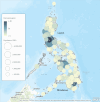The Distribution of Dermatologists in the Philippines
- PMID: 38883103
- PMCID: PMC11179128
- DOI: 10.7759/cureus.60402
The Distribution of Dermatologists in the Philippines
Abstract
Background: Equitable health manpower distribution is essential for the successful implementation of the Universal Health Care (UHC) program by the Philippine Department of Health. Mapping the distribution and profile of dermatologists in the Philippines can improve Filipinos' access to skin disease treatment.
Methods: A review of the database of dermatologists from the Philippine Dermatological Society (PDS) members' directory (as of November 2023), as well as the Philippine Health Insurance Corporation (PhilHealth) database (as of July 2023), was conducted. The distribution of PDS-accredited dermatologists was analyzed by geographic location, demographic profile (age and sex), density (per 100,000 people), and the dermatologist-to-general practitioner (GP) ratio. Heatmaps illustrating the distribution of dermatologists in the Philippines and the ratio of PhilHealth-accredited PDS board-certified dermatologists to GPs were created.
Results: Out of 1389 PDS board-certified dermatologists, 1345 resided in the Philippines. The majority were women (1221/1345, 90.78%), with a median age of 47 years (range: 23 to 85). More than half were practicing in the National Capital Region (NCR) (684/1345, 50.86%). The overall dermatologist density was approximately 1 per 100,000 people (1.19); it was highest for the Luzon Island group (1.54) (NCR, 4.80) and lowest for the Mindanao Island group (0.27; the Bangsamoro Autonomous Region of Muslim Mindanao or BARMM, 0.04). Less than one-third (396/1345, 29.44%) of dermatologists were PhilHealth-accredited, with a density of 0.35 dermatologists per 100,000 people. Out of 45218 PhilHealth-accredited physicians, 396 (0.88%) were dermatologists while 11748 (25.98%) were GPs. The overall dermatologist-to-GP ratio among PhilHealth-accredited physicians was 1:30; it was highest in the Luzon Island group (1:20) and lowest in the Mindanao Island group (1:118).
Conclusion: The Philippines lacks dermatologists in regions outside the NCR. The majority are women, and few are PhilHealth-accredited. The dermatologist-to-GP ratio among PhilHealth-accredited physicians is low. Dermatology training programs should encourage more applicants, especially men, and prioritize applicants from underserved regions.
Keywords: dermatologist; geographic distribution; health manpower; health workforce; philippines.
Copyright © 2024, Genuino et al.
Conflict of interest statement
The authors have declared that no competing interests exist.
Figures




Similar articles
-
Geographic Distribution of Cancer Care Providers in the Philippines.JCO Glob Oncol. 2022 Nov;8:e2200138. doi: 10.1200/GO.22.00138. JCO Glob Oncol. 2022. PMID: 36332171 Free PMC article.
-
The role of national health insurance for achieving UHC in the Philippines: a mixed methods analysis.Glob Health Action. 2018;11(1):1483638. doi: 10.1080/16549716.2018.1483638. Glob Health Action. 2018. PMID: 29914319 Free PMC article.
-
Association of SHI coverage and level of healthcare utilization and costs in the Philippines: a 10-year pooled analysis.J Public Health (Oxf). 2020 Nov 23;42(4):e496-e505. doi: 10.1093/pubmed/fdz142. J Public Health (Oxf). 2020. PMID: 31781739
-
The emerging role of physician assistants in the delivery of dermatologic health care.Dermatol Clin. 2000 Apr;18(2):297-302. doi: 10.1016/s0733-8635(05)70175-3. Dermatol Clin. 2000. PMID: 10791156 Review.
-
Lymphatic filariasis in the Philippines.Parasitol Today. 2000 Aug;16(8):329-33. doi: 10.1016/s0169-4758(00)01705-1. Parasitol Today. 2000. PMID: 10900480 Review.
References
-
- Republic Act No. 11223: an act instituting universal health care for all Filipinos, prescribing reforms in the health care system, and appropriating funds therefor. Republic Act No. 11223: An act instituting universal health care for all Filipinos, prescribing reforms in the health care system, and appropriating funds therefor. [ Feb; 2024 ]. 2019. https://www.officialgazette.gov.ph/2019/02/20/republic-act-no-11223/ https://www.officialgazette.gov.ph/2019/02/20/republic-act-no-11223/
-
- Universal healthcare is many years away (Opinion piece by Oscar P. Lagman, Jr.) [ Mar; 2024 ];Lagman OP. Universal healthcare is many years away (Opinion piece by Oscar P. https://www.pids.gov.ph/details/news/in-the-news/universal-healthcare-is... Lagman, Jr.). Philippine Institute for Development Studies; February. 2023 27:2023–2027.
-
- GBD compare. GBD Compare. [ Mar; 2024 ]. 2019. http://vizhub.healthdata.org/gbd-compare http://vizhub.healthdata.org/gbd-compare
LinkOut - more resources
Full Text Sources
Miscellaneous
